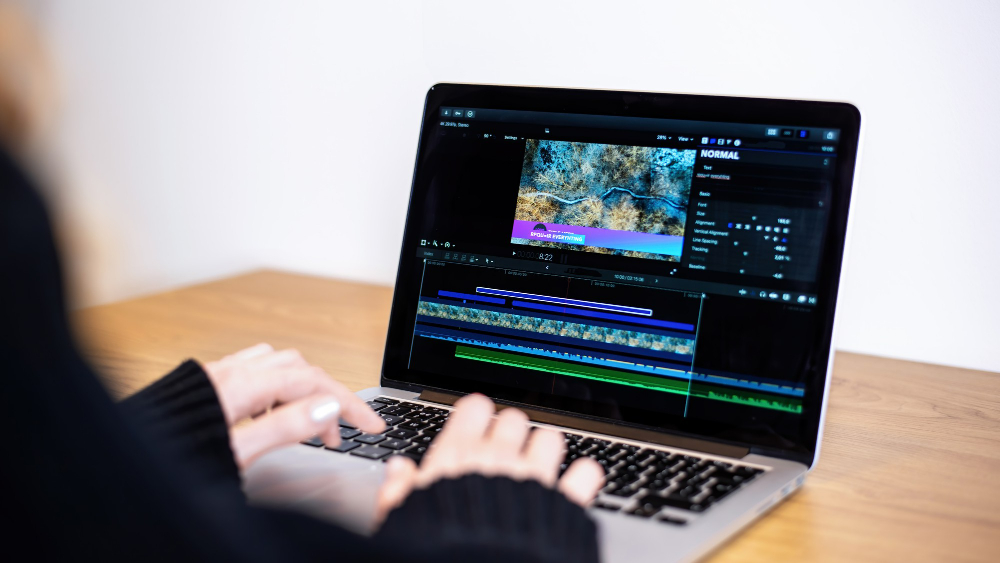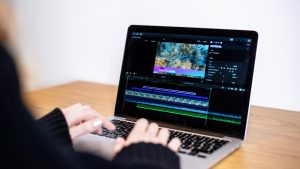Video editing is a cornerstone in the creation of engaging YouTube content. It’s the fine art of storytelling that transforms raw footage into compelling narratives. Effective video editing enhances the visual and auditory experience, keeping viewers hooked. Well-edited videos are known to significantly increase engagement. For instance, a study revealed that viewers are likely to spend 5x longer on well-edited videos, showcasing the substantial impact of polished editing on viewer retention.
Beyond enhancing viewer engagement, mastering video editing can contribute to personal growth for aspiring content creators. It’s a skill that cultivates creativity, patience, and technical prowess. By delving into the realm of video editing, individuals not only refine their storytelling abilities but also unlock new opportunities within the ever-evolving digital landscape. Through continuous learning and adaptation in editing techniques, content creators are setting the foundation for success on platforms like YouTube.
Selecting Video Editing Software
Choosing the right video editing software is a pivotal step in your YouTube content creation journey. The software acts as a medium where your creativity is transformed into engaging visuals and narratives.
Popular Video Editing Software Options
There are a plethora of video editing software options available catering to different skill levels and budget ranges. Among the top-tier choices are Adobe Premiere Pro and Final Cut Pro. Adobe Premiere Pro is highly favored for its comprehensive suite of editing tools and cross-platform compatibility, while Final Cut Pro is revered for its intuitive interface and robust functionality, albeit available only for macOS. On the other hand, for those on a budget or just starting out, DaVinci Resolve stands as a commendable free alternative offering professional-grade editing tools.
For beginners, DaVinci Resolve or other user-friendly options like iMovie may provide a smoother entry into the realm of video editing. They offer a range of basic to intermediate editing tools while maintaining a relatively simple user interface. On the flip side, more advanced users might find the extensive feature sets of Adobe Premiere Pro or Final Cut Pro more fulfilling for their complex editing needs. The choice largely depends on the individual’s proficiency level and the complexity of editing required for their YouTube content.
Considerations When Choosing Software
When it comes to selecting the right video editing software, several factors come into play. Your budget is a primary consideration, as professional-grade software like Adobe Premiere Pro and Final Cut Pro come with substantial licensing fees. System requirements are another crucial factor; ensuring your system can efficiently run the software is imperative. Features and user interface are also key aspects to consider, aligning with your editing skills and the nature of your YouTube content.
Market share statistics reflect the popularity and reliability of various software. A recent survey revealed that a significant percentage of YouTubers prefer Adobe Premiere Pro, indicating its industry acceptance. However, the growing popularity of free or lower-cost alternatives like DaVinci Resolve showcases a shift towards more budget-friendly yet competent options. Making an informed decision based on these considerations will significantly impact your video editing efficiency and the quality of your YouTube content.
Essential Video Editing Techniques
Video editing is an art that elevates raw footage into a captivating story. The mastery of various editing techniques is crucial for creating compelling and professional-looking videos for YouTube.
Cutting and Trimming Footage
The process of cutting and trimming footage is fundamental in video editing. It involves removing unnecessary or redundant footage, and ensuring that the video flows coherently from start to finish. Effective cutting and trimming help maintain the viewer’s interest and keep the narrative crisp and engaging.
Tools within editing software like the Razor Tool in Adobe Premiere Pro or the Blade Tool in Final Cut Pro are essential for making precise cuts. Shortcuts, like using keyboard commands, can significantly speed up the process. For instance, a before-and-after comparison of a video segment can show a cluttered narrative turning into a streamlined, engaging sequence post-trimming.
Adding Transitions
Transitions serve as bridges between scenes, ensuring a smooth flow and keeping the audience engaged. They can add a professional touch to your videos when used judiciously. Common transition types include cuts, fades, wipes, and more creative ones like whip pans or zoom transitions. The choice of transition should complement the narrative style and pace of your video.
A simple cut is often used for dialog-driven videos, while a dissolve might indicate a passage of time. A video demonstrating different transition styles can help understand the impact each has on the narrative and viewer engagement.
Color Correction and Grading
Color correction and grading play a vital role in enhancing the visual appeal of your video. Color correction is the art of fine-tuning the white balance, exposure, and contrast to achieve a natural and visually appealing look. On the other hand, color grading is a creative process that involves setting the mood and tone of a video by skillfully manipulating colors. Tools like the Lumetri Color panel in Adobe Premiere Pro or the color grading workspace in DaVinci Resolve are invaluable for these tasks.
A side-by-side comparison of a video frame before and after color grading can depict a dramatic transformation, enhancing the video’s aesthetic appeal and emotional impact.
Audio Enhancement
Audio is an indispensable component of video content that significantly influences viewer engagement. High-quality audio not only complements the visuals but also enhances the overall viewing experience.
Audio Editing Importance
The importance of good audio quality in video content cannot be overstated. It’s a critical factor that affects the viewer’s perception and engagement with the content. Poor audio quality can be distracting or irritating, leading to a loss of viewers. On the other hand, crisp and clear audio can keep viewers engaged and enhance the understanding and enjoyment of the content. Various studies have demonstrated the impact of good audio on viewer retention.
For instance, a study showcased that videos with better audio quality had a significantly higher viewer retention rate compared to those with poor audio quality. The findings underscore the crucial role of audio editing in video content creation.
Noise Reduction and Enhancement
Achieving clean audio entails reducing background noise and enhancing audio clarity. Background noise can be detrimental to audio quality, making it difficult for viewers to focus on the content. Various audio editing software and tools, like Adobe Audition or Audacity, offer noise reduction features that can help in minimizing unwanted sounds. Techniques such as using a noise reduction effect or setting up a noise gate can be effective in cleaning up the audio.
For example, an audio waveform displaying a recording before and after applying noise reduction techniques can show a notable reduction in background noise, leading to clearer, more intelligible audio. Moreover, enhancing audio clarity through equalization and compression can further polish the sound, making your video more professional and pleasant to watch.
Text and Graphics Overlay
Text and graphics overlay are vital tools in video editing, enhancing the conveyance of information and visual appeal. They play a crucial role in engaging viewers, providing context, and aiding in visual storytelling.
Adding Text Overlays
Text overlays are a powerful means to convey information, provide context, or add a layer of engagement to your videos. They can be used to display important facts, titles, captions, or even interactive elements like call-to-action buttons. Effective text overlays should be legible, well-timed, and complementary to the video content.
A video snippet showcasing a complex process can benefit immensely from text overlays that provide step-by-step explanations. Comparing a video snippet with and without text overlays can highlight the added value and clarity provided by well-designed text elements. Best practices include choosing a readable font, ensuring a suitable text size, and avoiding cluttering the screen.
Incorporating Graphics
Graphics are an essential aspect of visual storytelling, capable of transforming mundane visuals into engaging, informative, and entertaining content. They can be used to illustrate complex ideas, add visual interest, or reinforce branding. Tools like Adobe After Effects or Premiere Pro’s Essential Graphics panel are commonly used for creating and integrating graphics into videos.
When adding graphics, it’s crucial to ensure they align with the video’s theme and don’t distract from the main content. A before-and-after comparison of a video with and without graphics can depict a significant enhancement in visual appeal and informational value. Well-designed graphics can elevate the content, making it more engaging and visually stimulating for the audience.
Exporting and Uploading
The journey of video creation culminates in exporting the edited video and uploading it to YouTube. Both steps are crucial to ensuring that your content is presented in high quality and reaches your intended audience effectively.
Video Export Settings
Selecting the right export settings is pivotal as it affects both the video quality and the file size. Optimal settings ensure your video maintains high quality while not being excessively large in file size, which could cause longer upload times and potential playback issues. Recommended export settings for YouTube include a high-resolution option, such as 1080p or 4K, a frame rate that matches your source footage (commonly 24, 30, or 60 frames per second), and a high bitrate to maintain quality. Additionally, YouTube suggests using the H.264 codec for video compression as it provides a good balance between quality and file size. A guide detailing the ideal export settings for various video resolutions can serve as a valuable resource for ensuring your content looks crisp and professional on the platform.
Uploading to YouTube
Uploading edited videos to YouTube is a straightforward yet crucial process. Start by signing in to your YouTube account, then click on the “Create” icon at the top right corner and select “Upload Video.” From here, you can drag and drop your video file or select it from your device. While your video is uploading, it’s essential to optimize your video titles, descriptions, and tags as these elements significantly impact your video’s discoverability. Craft a catchy, relevant title, include a descriptive summary in the description box, and use relevant tags to improve your video’s searchability. Screenshots of the YouTube video upload process can serve as a visual guide, ensuring you don’t miss any critical steps. Also, take advantage of YouTube’s scheduling feature if you prefer to have your video go live at a specific time.
Troubleshooting and Advanced Techniques
Delving deeper into video editing opens a realm of advanced techniques, yet may also present unforeseen challenges. Troubleshooting common issues and mastering advanced skills are part of the continuous learning curve in video editing.
Common Editing Problems and Solutions
Video editors often encounter challenges such as video quality degradation, synchronization issues between audio and video, or even software crashes. Troubleshooting these problems involves identifying the root cause and applying the necessary fixes. For instance, video quality issues can often be resolved by ensuring the correct export settings are used. There are numerous case studies of creators who faced, analyzed, and overcame such editing issues, evolving in their editing journey. A step-by-step guide to fixing common problems, like video quality issues, can serve as a useful resource for many facing similar challenges.
Advanced Editing Techniques
Advanced editing techniques like motion tracking, animation, and green screen usage significantly broaden the creative horizon. Motion tracking allows for dynamic interaction between elements within the video, animation can bring unique storytelling aesthetics, and green screen usage enables a myriad of background replacement possibilities.
Various creative videos showcase these advanced techniques, providing a glimpse into the extent of creativity and professionalism achievable with advanced editing. A video demonstration of motion tracking, for instance, can provide a visual understanding and inspire editors to explore this technique further.
Practice and Persistence
The journey from a novice to a proficient video editor is paved with consistent practice and a willingness to learn. Continuous learning, exploring new techniques, and solving encountered problems are key to honing one’s editing skills.
Success stories of creators who started with basic edits and progressed to creating professional-quality content are plentiful. They serve as motivation and a testament to what practice and persistence in video editing can achieve. Through diligent practice, learning from mistakes, and exploring advanced editing techniques, creators can significantly elevate the quality of their content, contributing to their success on platforms like YouTube.
Mastering the art of video editing is a rewarding endeavor that significantly uplifts the quality and engagement of YouTube content. From selecting the right editing software, understanding basic to advanced editing techniques, to efficiently exporting and uploading the final product, each step is a learning experience that molds a more skilled and confident content creator. As the digital realm continues to evolve, staying adept with the latest editing tools and techniques, coupled with a passion for continuous learning, will empower creators to produce captivating content that resonates with and grows their audience on YouTube.





